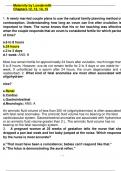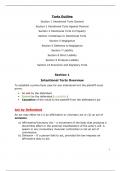Maternity by Lowdermilk
Chapters 12, 13, 14, 15
1. A newly married couple plans to use the natural family planning method of
contraception. Understanding how long an ovum can live after ovulation is
important to them. The nurse knows that his or her teaching was effective
when the couple responds that an ovum is considered fertile for which period
of time?
a.6 to 8 hours
b.24 hours
c.2 to 3 days
d.1 week: ANS: B
Most ova remain fertile for approximately 24 hours after ovulation, much longer than
6 to 8 hours. However, ova do not remain fertile for 2 to 3 days or are viable for 1
week. If unfertilized by a sperm after 24 hours, the ovum degenerates and is
reabsorbed. 2. What kind of fetal anomalies are most often associated with
oligohydram-
nios?
a.Renal
b.Cardiac
c.Gastrointestinal
d.Neurologic: ANS: A
An amniotic fluid volume of less than 300 ml (oligohydramnios) is often associated
with fetal renal anomalies. The amniotic fluid volume has no bearing on the fetal
cardiovascular system. Gastrointestinal anomalies are associated with hydramnios
or an amniotic fluid volume greater than 2 L. The amniotic fluid volume has no
bearing on the fetal neurologic system.
3. A pregnant woman at 25 weeks of gestation tells the nurse that she
dropped a pan last week and her baby jumped at the noise. Which response
by the nurse is most accurate?
a."That must have been a coincidence; babies can't respond like that."
b."The fetus is demonstrating the aural reflex."
, Maternity by Lowdermilk
Chapters 12, 13, 14, 15
c."Babies respond to sound starting at approximately 24 weeks of gestation."
d."Let me know if it happens again; we need to report that to your midwife.":
ANS: C
Babies respond to external sound starting at approximately 24 weeks of gestation.
Acoustic stimulations can evoke a fetal heart rate response. There is no such
thing as an aural reflex. The last statement is inappropriate and may cause undue
psychologic alarm to the client.
4. At a routine prenatal visit, the nurse explains the development of the
fetus to her client. At approximately ____ weeks of gestation, lecithin is
forming on the alveolar surfaces, the eyelids open, and the fetus measures
approximately 27 cm crown to rump and weighs approximately 1110 g. The
client is how many weeks of gestation at today's visit?
a.20
b.24
c.28
d.30: ANS: C
These milestones in human development occur at 28 weeks of gestation. These
milestones have not occurred by 20 or 24 weeks of gestation but have been reached
before 30 weeks of gestation.
5. Which statement regarding the structure and function of the placenta is
correct?
a.Produces nutrients for fetal nutrition
b.Secretes both estrogen and progesterone
c.Forms a protective, impenetrable barrier to microorganisms such as
bacteria and viruses
d.Excretes prolactin and insulin: ANS: B
As one of its early functions, the placenta acts as an endocrine gland, producing
four hormones necessary to maintain the pregnancy and to support the embryo or
fetus: human chorionic gonadotropin (hCG), human placental lactogen (hPL),
, Maternity by Lowdermilk
Chapters 12, 13, 14, 15
estrogen, and progesterone. The placenta does not produce nutrients. It functions
as a means of metabolic exchange between the maternal and fetal blood supplies.
Many bacteria and viruses can cross the placental membrane.
6. A woman in labor passes some thick meconium as her amniotic fluid
ruptures. The client asks the nurse where the baby makes the meconium.
What is the correct response by the nurse?
a.Fetal intestines
b.Fetal kidneys
c.Amniotic fluid
d.Placenta: ANS: A
As the fetus nears term, fetal waste products accumulate in the intestines as dark
green-to-black, tarry meconium. Meconium is not produced by the fetal kidneys
nor should it be present in the amniotic fluid, which may be an indication of fetal
compromise. The placenta does not produce meconium.
7. A woman asks the nurse, "What protects my baby's umbilical cord from
being squashed while the baby's inside of me?" What is the nurse's best
response?
a."Your baby's umbilical cord is surrounded by connective tissue called
Wharton's jelly, which prevents compression of the blood vessels."
b."Your baby's umbilical cord floats around in blood and amniotic fluid."
c."You don't need to be worrying about things like that."
d."The umbilical cord is a group of blood vessels that are very well protected
by the placenta.": ANS: A
Explaining the structure and function of the umbilical cord is the most appropriate
response. Connective tissue called Wharton's jelly surrounds the umbilical cord,
prevents compression of the blood vessels, and ensures continued nourishment of
the embryo or fetus. The umbilical cord does not float around in blood or fluid.
Telling the client not to worry negates her need for information and discounts her
feelings. The placenta does not protect the umbilical cord.
8. Which structure is responsible for oxygen and carbon dioxide transport to
and from the maternal bloodstream?
, Maternity by Lowdermilk
Chapters 12, 13, 14, 15
a.Decidua basalis
b.Blastocyst
c.Germ layer
d.Chorionic villi: ANS: D
Chorionic villi are fingerlike projections that develop out of the trophoblast and
extend into the blood-filled spaces of the endometrium. The villi obtain oxygen and
nutrients from the maternal bloodstream and dispose carbon dioxide and waste
products into the maternal blood. The decidua basalis is the portion of the decidua
(endometrium) under the blastocyst where the villi attach. The blastocyst is the
embryonic development stage after the morula; implantation occurs at this stage.
The germ layer is a layer of the blastocyst.
9. A client arrives for her initial prenatal examination. This is her first child.
She asks the nurse, "How does my baby get air inside my uterus?" What is
the correct response by the nurse?
a."The baby's lungs work in utero to exchange oxygen and carbon dioxide."
b."The baby absorbs oxygen from your blood system."
c."The placenta provides oxygen to the baby and excretes carbon dioxide into
your bloodstream."
d."The placenta delivers oxygen-rich blood through the umbilical artery to the
baby's abdomen."
Alternative: Sally comes in for her first prenatal examination. This is her first
child. She asks you (the nurse), "How does my baby get air inside my uterus?"
The correct response is:: ANS: C
The placenta delivers oxygen-rich blood through the umbilical vein, not the artery,
to the fetus and excretes carbon dioxide into the maternal bloodstream. The fetal
lungs do not function as respiratory gas exchange in utero. The baby does not
simply absorb oxygen from a woman's blood system; rather, blood and gas
transport occur through the placenta.
10. What is the most basic information that a nurse should be able to share
with a client who asks about the process of conception?
a.Ova are considered fertile 48 to 72 hours after ovulation.





